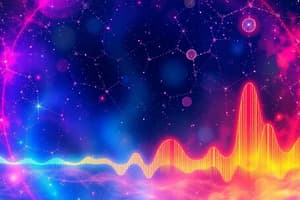Podcast
Questions and Answers
What is the correct range of wavelengths for the near infrared (Near IR) region?
What is the correct range of wavelengths for the near infrared (Near IR) region?
- 3-15 um
- 380-780 nm
- 780-3000 nm (correct)
- 200-380 nm
What does Planck’s constant describe?
What does Planck’s constant describe?
- The energy levels of an electron in an atom
- The speed of light in a vacuum
- The spectral density of electromagnetic radiation from a black body (correct)
- The wavelength of ultraviolet light
Which of the following correctly defines frequency in the context of electromagnetic radiation?
Which of the following correctly defines frequency in the context of electromagnetic radiation?
- Number of complete wave cycles per second (correct)
- Swing of the wave from peak to trough
- Distance between peaks of the wave
- Number of waves per unit length
Which region corresponds to a wavelength range of 15-300 um?
Which region corresponds to a wavelength range of 15-300 um?
What is the wavelength range for the UV region of electromagnetic radiation?
What is the wavelength range for the UV region of electromagnetic radiation?
What determines whether a chemical species absorbs or transmits radiant energy?
What determines whether a chemical species absorbs or transmits radiant energy?
Which of the following forms of energy is not used in Spectrometry?
Which of the following forms of energy is not used in Spectrometry?
What is the range of the UV spectrum mentioned?
What is the range of the UV spectrum mentioned?
In the equation $E=Ee+Ev+Er+Et$, what does E represent?
In the equation $E=Ee+Ev+Er+Et$, what does E represent?
What happens to non-bonding electrons when radiant energy is absorbed?
What happens to non-bonding electrons when radiant energy is absorbed?
Which orbital state is referred to as the antibonding state?
Which orbital state is referred to as the antibonding state?
What types of electrons are involved in UV and Visible Spectroscopy?
What types of electrons are involved in UV and Visible Spectroscopy?
How are sigma and pi electrons described when they reach the antibonding state?
How are sigma and pi electrons described when they reach the antibonding state?
Flashcards are hidden until you start studying
Study Notes
Spectrometry Overview
- Spectrometry analyzes molecules by observing their interaction with light, employing electromagnetic radiation.
- Energy in electromagnetic (EM) spectrum is propagated in waveforms, utilizing various light forms like UV, visible, and infrared (IR) radiation.
Wavelength and Regions
- Wavelength represents the distance between wave peaks, measured in micrometers (um) or nanometers (nm).
- Wavelengths characteristic of specific regions:
- UV: 200-380 nm
- Visible: 380-780 nm
- Near IR: 780-3000 nm
- Medium IR: 3-15 um
- Far IR: 15-300 um
Theories of Radiant Energy
- Energy in the EM spectrum is quantized, occurring in bundles called photons or quanta.
- Planck’s constant describes the spectral density of electromagnetic radiation from a black body at thermal equilibrium at temperature T, where energy content determines chemical absorption or transmission.
- Absorbance refers to light energy absorbed by photons, while transmission indicates the light exiting the sample.
States of Molecules
- Molecules exist in specific energy states and cannot have arbitrary energy levels.
- Energy absorption moves molecules from an initial state to a higher energy state.
- Internal energy (E) of a molecule at a given temperature is the sum of electronic (Ee), vibrational (Ev), and rotational (Er) energies, plus translational energy (Et), expressed as E = Ee + Ev + Er + Et.
- Translational energy does not apply in spectrometry; Ee is relevant in UV-visible regions, while Ev and Et pertain to the IR region.
UV and Visible Spectroscopy
- Molecules respond primarily to UV (185-380 nm) and visible (380-780 nm) light.
- Electronic excitation occurs in these spectra, affecting non-bonding (n) electrons and sigma (σ) or pi (π) bonds.
- Absorption of radiant energy elevates molecules to higher energy states in antibonding orbitals, termed σ* or π* for sigma and pi electrons, respectively.
Sigma Electrons
- Sigma electrons exhibit strong bonds with carbon atoms; disruption of these bonds requires energy in the far UV region.
Studying That Suits You
Use AI to generate personalized quizzes and flashcards to suit your learning preferences.



